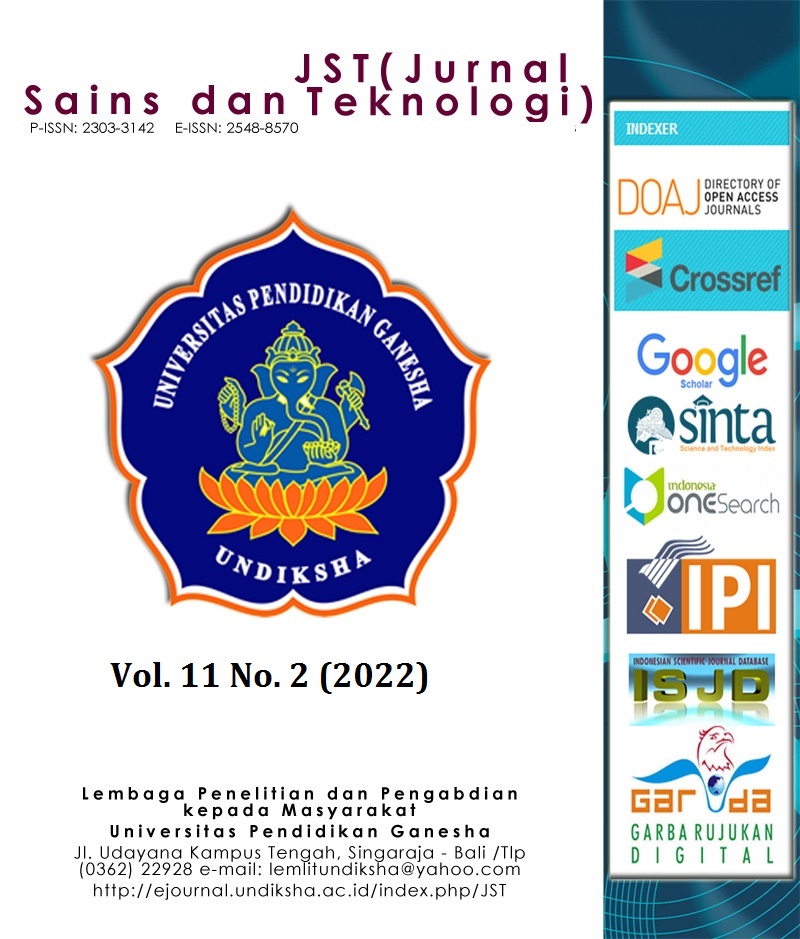PERANCANGAN SISTEM DETEKSI KADAR CO2 PADA RUANGAN TERTUTUP MENGGUNAKAN METODE FUZZY LOGIC MAMDANI TERKONEKSI TELEGRAM
DOI:
https://doi.org/10.23887/jstundiksha.v11i2.47043Kata Kunci:
Fuzzy Mamdani, Sensor, Gas Co2Abstrak
Pencemaran udara dapat terjadi di dalam ruangan, salah satu sumbernya adalah respirasi manusia. Respirasi mengeluarkan gas karbon dioksida yang dapat menyebabkan keracunan jika dihirup berlebihan. Keracunan karbon dioksida dapat menyebabkan berbagai penyakit hingga kematian. Maka dibuatlah alat pendeteksi kadar karbon dioksida agar menghindari terjadinya keracunan dilengkapi exhaust sebagai alat mengurangi kadar karbon dioksida dan aplikasi telegram sebagai media informasi. Sistem menggunakan input sensor MG-811 sebagai deteksi kadar karbon dioksida dengan tingkat akurasi sangat tinggi dibandingkan jenis sensor lainnya dan sensor HC-SR04 untuk mendeteksi jumlah orang. Exhaust sebagai output menggunakan metode Logika Fuzzy Mamdani untuk menentukan lama exhaust aktif. Pengujian dilakukan dengan 3 kategori yaitu 3 orang, 5 orang, dan 9 orang. Hasil pengujian Rules Fuzzy pada sistem hanya memiliki error 1,09% dibandingkan MATLAB, nilai tersebut dapat dikategorikan sangat kecil. Selanjutnya jumlah ideal orang untuk ruangan 3x4 meter adalah kurang dari 5 orang untuk menghindari terjadinya keracunan akibat gas karbon dioksida
Referensi
Abidin, J., Artauli Hasibuan, F., Kunci, K., Udara, P., & Gauss, D. (2019). Pengaruh Dampak Pencemaran Udara Terhadap Kesehatan Untuk Menambah Pemahaman Masyarakat Awam Tentang Bahaya Dari Polusi Udara. Prosiding SNFUR-4, 2(2), 978–979.
Amsar, A., Khairuman, K., & Marlina, M. (2020). Perancangan Alat Pendeteksi CO2 Menggunakan Sensor MQ-2 Berbasis Internet Of Thing. METHOMIKA: Jurnal Manajemen Informatika Dan Komputerisasi Akuntansi, 4(1), 73–79. https://doi.org/10.46880/jmika.v4i1.143.
Batubara, S. (2017). Analisis Perbandingan Metode Fuzzy Mamdani Dan Fuzzy Sugeno Untuk Penentuan Kualitas Cor Beton Instan. It Journal Research and Development, 2(1), 1–11. https://doi.org/10.25299/itjrd.2017.vol2(1).644.
Dengo, M. R., Suwondo, A., & Suroto, S. (2018). Hubungan Paparan CO terhadap Saturasi Oksigen dan Kelelahan Kerja pada Petugas Parkir. Gorontalo Journal of Public Health, 1(2), 78–84. https://doi.org/10.32662/gjph.v1i2.347.
Gopinath, A., Arun, C., Hanumanthaiah, A., & Murugan, R. (2020). An analogy of the datalogger implementation in arduino UNO and PSoC5LP. Proceedings of the 3rd International Conference on Smart Systems and Inventive Technology, ICSSIT 2020, Icssit, 328–332. https://doi.org/10.1109/ICSSIT48917.2020.9214222.
Kamal, A. M., Hemel, S. H., & Ahmad, M. U. (2019). Comparison of Linear Displacement Measurements between A Mems Accelerometer and Hc-Sr04 Low-Cost Ultrasonic Sensor. 1st International Conference on Advances in Science, Engineering and Robotics Technology 2019, ICASERT 2019, 2019(Icasert), 1–6. https://doi.org/10.1109/ICASERT.2019.8934569.
Kesehatan, M., & Indonesia, R. (2011). Peraturan Mentri Kesehatan Indonesia No 1077/Menkes/PER/2011.
Komuro, N., Hashiguchi, T., Hirai, K., & Ichikawa, M. (2021). Predicting individual emotion from perception-based non-contact sensor big data. Scientific Reports 2021 11:1, 11(1), 1–9. https://doi.org/10.1038/s41598-021-81958-2.
Macheso, P., Manda, T. D., Chisale, S., Dzupire, N., Mlatho, J., & Mukanyiligira, D. (2021). Design of ESP8266 Smart Home Using MQTT and. IEEE, 502–505. https://doi.org/10.1109/ICAIS50930.2021.9396027.
Mulia, N. A., Hanafi, M. H., & Arwani, I. (2018). Implementasi Logika Fuzzy untuk Purwarupa Pengkondisian AC dan Lampu Otomatis pada Sebuah Ruangan. Jurnal Pengembangan Teknologi Informasi Dan Ilmu Komputer, 2(4), 1553–1562. https://j-ptiik.ub.ac.id/index.php/j-ptiik/article/view/1261.
Qory Hidayati, F. Z. R. (2020). Sistem Monitoring Kualitas Udara Berbasis Fuzzy Logic. Prosiding Seminar Nasional Terapan Riset Inovatif (SENTRINOV), 6(1), 260–267. https://proceeding.isas.or.id/index.php/sentrinov/article/view/373.
Raza, K. A., & Monnet, W. (2019). Moving objects detection and direction-finding with HC-SR04 ultrasonic linear array. Proceedings of the 5th International Engineering Conference, IEC 2019, 153–158. https://doi.org/10.1109/IEC47844.2019.8950639.
Rosli, R. S., Habaebi, M. H., & Islam, M. R. (2018). Characteristic Analysis of Received Signal Strength Indicator from ESP8266 WiFi Transceiver Module. Proceedings of the 2018 7th International Conference on Computer and Communication Engineering, ICCCE 2018, 504–507. https://doi.org/10.1109/ICCCE.2018.8539338.
Rufino, J., Alam, M., Almeida, J., & Ferreira, J. (2017). Software defined P2P architecture for reliable vehicular communications. Pervasive and Mobile Computing, 42, 411–425. https://doi.org/10.1016/j.pmcj.2017.06.014.
Setyawan, B., Andryana, S., & Winarsih, W. (2018). Sistem Deteksi Menggunakan Sensor Ultrasonik berbasis Arduino mega 2560 dan Processing untuk Sistem Keamanan Rumah. J I M P - Jurnal Informatika Merdeka Pasuruan, 3(3), 15–20. https://doi.org/10.37438/jimp.v3i3.183.
Sidik, M. F., & Rahmad, I. F. (2021). Monitoring Kondisi Udara Di Kota Medan Dengan Pendekatan Fuzzy Logic Berbasis Internet of Things (IoT). It (Informatic Technique) Journal, 8(1), 73–80. https://doi.org/10.22303/it.8.1.2020.73-80.
Susanti, R., Yazid, H., & Azriful, R. K. (2021). Alat Uji Karbon Dioksida Pada Kopi Sebagai Indikator Kelayakan Untuk Dikonsumsi. Prosiding SISFOTEK, 5(1), 191–195. http://www.seminar.iaii.or.id/index.php/SISFOTEK/article/view/281.
Thakur, D., Kumar, Y., & Kumar, A. (2019). Applicability of wireless sensor networks in precision agriculture: A review. Wireless Personal Communications, 107, 471–512. https://doi.org/10.1007/s11277-019-06285-2.
Zhao, Z., Wang, J., Fu, C., Liu, Z., Liu, D., & Li, B. (2018). Design of a smart sensor network system for real-time air quality monitoring on green roof. Journal of Sensors. https://doi.org/10.1155/2018/1987931.
Zinkevich, A. V. (2021). ESP8266 Microcontroller Application in Wireless Synchronization Tasks. In 2021 International Conference on Industrial Engineering, Applications and Manufacturing (ICIEAM) (. IEEE, 670–674. https://doi.org/10.1109/ICIEAM51226.2021.9446411.
Unduhan
Diterbitkan
Cara Mengutip
Terbitan
Bagian
Lisensi
Hak Cipta (c) 2022 Yesyurun Masiakh Agape, Deddy Susilo, Andreas Febrianto

Artikel ini berlisensiCreative Commons Attribution-ShareAlike 4.0 International License.
Authors who publish with the Jurnal Sains dan Teknologi (JST) agree to the following terms:
- Authors retain copyright and grant the journal the right of first publication with the work simultaneously licensed under a Creative Commons Attribution License (CC BY-SA 4.0) that allows others to share the work with an acknowledgment of the work's authorship and initial publication in this journal.
- Authors are able to enter into separate, additional contractual arrangements for the non-exclusive distribution of the journal's published version of the work (e.g., post it to an institutional repository or publish it in a book), with an acknowledgment of its initial publication in this journal.
- Authors are permitted and encouraged to post their work online (e.g., in institutional repositories or on their website) prior to and during the submission process, as it can lead to productive exchanges, as well as earlier and greater citation of published work. (See The Effect of Open Access)
















